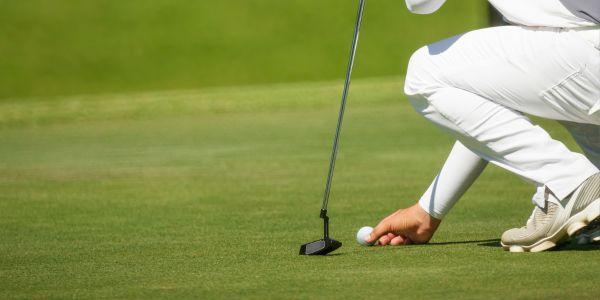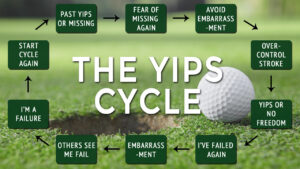
What Causes Your Putting to Change on The Course?
I received a messaged from Joe about his putting… He said the following:
“I can putt very well on the practice green. I was always a good putter. But now, once I get on the course with others, the yips enter the game. I get last minute twitches that send the ball everywhere but the hole, even on short putts. I’ve tried closing my eyes and focusing on the butt end of the putter with minimal success. I’m very open to solutions to overcome this.”
So Joe says he’s a good putter and can putt well on the practice green. When do the problems start? Only on the course.
Putting is the same task on the course, right? On the course with others is when the putter gets shaky…
So I can conclude that the worry is about what others think about his putting or the fact that it’s a round for score is the main source of anxiety.
Whats The Trigger On The Course:
It’s the perceived pressure for most golfers. Joe either is afraid of what others think of his putting or he badly wants to score well.
On the course, putting is now more important. When it’s more important, that leads to trying harder and or worrying about outcomes: missing or shooing a bad score.
For most golfers, this leads to over control, and over control or thinking leads to thinking too much about stroke, grip, stance, and mechanics in general.
Here’s The Key In The Yips Cycle:
Missing leads to worry, and this leads to over thinking, which leads to the feeling of yipping.

What’s The Solution?
You have to attach the yips cycle at every stage.
Back to Joe… The fear of embarrassment of others’ evaluation of his poor putting is keeping him stuck in the yips cycle…
To allow that “good putter” to return, he has to learn to putt without regard to others’ views and focus on what’s relevant to good putting.
9 out of 10 golfers with the yips worry about what others think of their game. They try to avoid the embarrassment that comes with missing short putts.
It’s not easy, but Joe has to learn to let go of trying to make a good stroke or analyzing what it feels like and focus on the target or pace of the putt.
Good putting is all about line and pace (after the read of course), not about stoke. In the yips cycle, golfers focus WAY TOO much on stroke.
Thus, you have to adopt an “I don’t care what others think about my putting” mindset and focus on the most important cues in putting line and pace.
Have you ever heard of the statement “get out of your own way?” That’s what Joe has to do to have his good putting come out on the course.
Start by checking my model of the yips cycle and see if it applies to you:

Related Golf Psychology Articles
- How to Beat the Yips and Putting Anxiety
- Does Your Putting Change on the Course?
- Why the Putting Yips Show Up When It’s Important
- Subscribe to The Golf Psychology Podcast on iTunes
- Subscribe to The Golf Psychology Podcast on Spotify
Get the Mental Edge – With Mental Training

Do you perform well in practice, but find yourself under-performing in games? Do you doubt your skills and second-guess yourself under pressure? If so, mental training will help you reach your goals in soccer. Many soccer players have the skill but are held back by low confidence and lack of pregame mental preparation!
You can get expert mental coaching with us from anywhere. Meet with us via Zoom, Skype, FaceTime or phone call. With today’s video technology, we are able to connect with athletes and coaches all over the globe.
Call Us Today to Schedule Your Free 15-Minute Session.
Find Out How You Can Benefit From One-on-One Mental Coaching!
888-742-7225 | 407-909-1700
Your yips cycle describes the putting hell I am in today. So how do you adopt an I don’t care what others think about my putting mindset.